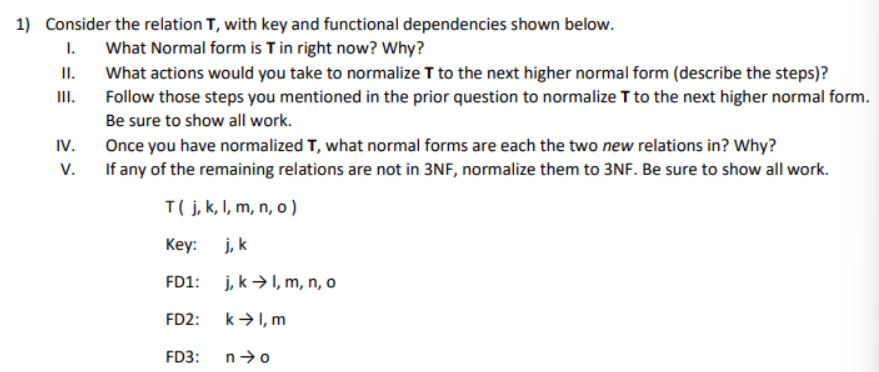Consider the relation T, with key and functional dependencies shown below. I. What Normal form is T in right now? Why? II. III. What actions would you take to normalize T to the next higher normal form (describe the steps)? Follow those steps you mentioned in the prior question to normalize T to the next higher normal form. Be sure to show all work. IV. V. Once you have normalized T, what normal forms are each the two new relations in? Why? If any of the remaining relations are not in 3NF, normalize them to 3NF. Be sure to show all work. T( j, k, l, m, n, o) Key: j, k j, k→ l, m, n, o k→l, m n➜o FD1: FD2: FD3:
Consider the relation T, with key and functional dependencies shown below. I. What Normal form is T in right now? Why? II. III. What actions would you take to normalize T to the next higher normal form (describe the steps)? Follow those steps you mentioned in the prior question to normalize T to the next higher normal form. Be sure to show all work. IV. V. Once you have normalized T, what normal forms are each the two new relations in? Why? If any of the remaining relations are not in 3NF, normalize them to 3NF. Be sure to show all work. T( j, k, l, m, n, o) Key: j, k j, k→ l, m, n, o k→l, m n➜o FD1: FD2: FD3:
Computer Networking: A Top-Down Approach (7th Edition)
7th Edition
ISBN:9780133594140
Author:James Kurose, Keith Ross
Publisher:James Kurose, Keith Ross
Chapter1: Computer Networks And The Internet
Section: Chapter Questions
Problem R1RQ: What is the difference between a host and an end system? List several different types of end...
Related questions
Question
100%
correct answers will get thumbs up

Transcribed Image Text:1) Consider the relation T, with key and functional dependencies shown below.
1.
What Normal form is T in right now? Why?
What actions would you take to normalize T to the next higher normal form (describe the steps)?
Follow those steps you mentioned in the prior question to normalize T to the next higher normal form.
Be sure to show all work.
II.
III.
IV.
V.
Once you have normalized T, what normal forms are each the two new relations in? Why?
If any of the remaining relations are not in 3NF, normalize them to 3NF. Be sure to show all work.
T( j, k, l, m, n, o)
Key:
j, k
FD1: j, k→ l, m, n, o
FD2:
k→ I, m
FD3:
n➜o
Expert Solution
This question has been solved!
Explore an expertly crafted, step-by-step solution for a thorough understanding of key concepts.
This is a popular solution!
Trending now
This is a popular solution!
Step by step
Solved in 6 steps

Recommended textbooks for you

Computer Networking: A Top-Down Approach (7th Edi…
Computer Engineering
ISBN:
9780133594140
Author:
James Kurose, Keith Ross
Publisher:
PEARSON

Computer Organization and Design MIPS Edition, Fi…
Computer Engineering
ISBN:
9780124077263
Author:
David A. Patterson, John L. Hennessy
Publisher:
Elsevier Science

Network+ Guide to Networks (MindTap Course List)
Computer Engineering
ISBN:
9781337569330
Author:
Jill West, Tamara Dean, Jean Andrews
Publisher:
Cengage Learning

Computer Networking: A Top-Down Approach (7th Edi…
Computer Engineering
ISBN:
9780133594140
Author:
James Kurose, Keith Ross
Publisher:
PEARSON

Computer Organization and Design MIPS Edition, Fi…
Computer Engineering
ISBN:
9780124077263
Author:
David A. Patterson, John L. Hennessy
Publisher:
Elsevier Science

Network+ Guide to Networks (MindTap Course List)
Computer Engineering
ISBN:
9781337569330
Author:
Jill West, Tamara Dean, Jean Andrews
Publisher:
Cengage Learning

Concepts of Database Management
Computer Engineering
ISBN:
9781337093422
Author:
Joy L. Starks, Philip J. Pratt, Mary Z. Last
Publisher:
Cengage Learning

Prelude to Programming
Computer Engineering
ISBN:
9780133750423
Author:
VENIT, Stewart
Publisher:
Pearson Education

Sc Business Data Communications and Networking, T…
Computer Engineering
ISBN:
9781119368830
Author:
FITZGERALD
Publisher:
WILEY